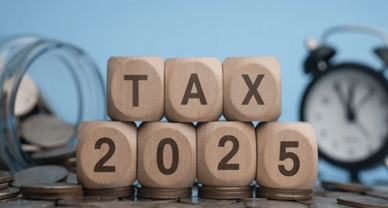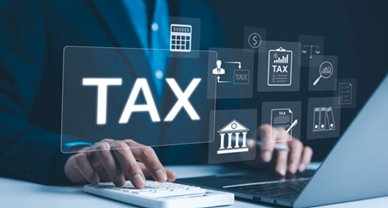Indirect Tax Amendments in 2025 Budget: Planning Strategies for Copyright Royalties in Media Industry
Introduction: Navigating Fiscal Change in a Digital Media Ecosystem
The Indian media and entertainment sector (which is estimated to have a worth amounting to INR 2.5 lakh crore in FY 2025) depends heavily on the copyright-related subscription fees of the OTT and the music subscription as the major source of income. The unlimited direct taxation has penetrated in the online royalty dealings as 650 million internet users and a CAGR of 22% in online video use is recorded.
The 2025-26 Budget defined extensive changes in the indirect taxation with reference to the borderless environment of the digital economy, which are embodied in the Finance Bill, 2025. These include amendments to the Act of Integrated Goods and services tax (IGST) Act under Section 2(16) which provided expansion of the scope of Online information database access and retrieval (OIDAR) service to non-business entities, and the procedural amendments on sections 107 and 112 of the Central Goods and Services tax (CGST) Act in the areas of appeals.
These amendments are after a yearly projected leakage of revenue of INR 5,000 crore in the form of untaxed digital royalty and a 30% growth in GST litigation against the media firms. This paper analyses the implications of these changes, with a focus on the strategic compliance mechanisms, and their overall effects to the royalty of copying systems in the entertainment industry.
The 2025 Budget Amendments: GST Changes for Digital Licensing
Finance Bill 2025 had important GST changes including the extension of OIDAR to Section 2(16), IGST Act, which is an issue of vital importance when it comes to the digital licensing of content. Previously, OIDAR such as automated digital services, e-books, and software royalty, was only taxed at 18% when accessed by registered users or distributed to non-business unregistered consumers through intermediaries. Under this amendment, this liability has been expanded concept to include all supplies made by non-taxable territories directly to unregistered persons in India, irrespective of the business relationship on the condition maker of the suppliers consent so that data interoperability governments can be used.

This transition is required to have foreign OIDAR providers who have annual supplies of more than INR 20 lakh, and reverse charge mechanism (RCM) requirements in this case. Transactional integration of the OIDAR under the GSTR-1, GSTR-3B, e-invoicing, and e-way bills increases the traceability. This is defensible by fiscal parity- in the years before 2025 approximately 40% of digital royalties were not subject to GST because of unregistered access, which is not experienced by Indian services such as JioCinema which paid GST of 18% on licensing. Since April 1, 2025, this discrepancy will be closed, and it is estimated that it will enable collecting more INR 2,000 crore in increased GST, in accordance with the traceability goals of the Digital India Act.
Additionally, CGST Section 122(1B) provides remedies of violations committed by the operator of e-commerce that facilitates unregistered digital supplies having a maximum penalty of INR 10,000 or the amount of taxes due. In spite of the current levels of rates, the compliance burden widens, which encourages the media companies to review royalty frameworks, determine OIDAR exposure and enhance tax-planning responses.
Planning Strategies for Copyright Royalties: Minimizing Compliance Exposure
Since royalty amounts to almost 35% of sectoral revenue, the broadened scope of OIDAR requires long-term restructuring to reduce the cumulative liabilities. The companies should start with detailed inbound digital licensing audits. To illustrate, an OTT service in Mumbai to which a U.S.-based content is being sourced ought to utilize KYC-based profiling to detect unregistered consumers and report voluntarily to avoid RCM heavy loads. By using API-based compliance tools provided by GSTN, liability exposure can be lowered by about 25 as illustrated in the quarter 1 2025 reports of Eros International. The liquidity level is important as the amount of 18% GST on royalties can be non-recovered in a B2C business. channeling supplies via registered Indian subsidiaries allow input tax credit (ITC) benefits, and costs can be reduced by up to 15 by using hybrid models. Re-organizing of Zee Entertainment in 2025_ended royalty inflows of INR 300 crore through this channel, it is said. The media companies are also advised to include clauses within the contracts as mandated by OIDAR-compliance as a precaution to obtain data-sharing consent and prevent the penalty, which has increased 20% since the amendment. In case of outbound royalties e.g. Bollywood exports into Southeast Asia; advance pricing agreements (APAs) can be used to provide arm-length GST allocation minimizing dual taxation under the India-ASEAN DTAA framework. FICCI 2025 Media Outlook reported a 12% ROI of such compliance-based strategies, and companies such as T-Series were enjoying steady flows of ICT credit. Nevertheless, those actions go hand in hand with the changing categorization issues and applicability of RCM, which requires the careful utilization of the reformed dispute resolution procedures.
Analytical Appraisal: Dispute Resolution Routes for Entertainment Firms
The amendments in 2025 reinvent the struggle to resolve the GST dispute greatly. Adjustments in CGST Section 107 and 112 that lead to compulsory pre-deposits whilst appealing to cases will change the litigation environment in entertainment companies. Earlier, orders without a deposit (to penalize easy categories based on royalty misclassification, the highest place of which 28% of disputes in 2024) used to be made without a pre-deposit, with the result of extension of appeal up to a period of 2 years to a backlog of 1.2 lakh cases. The appellants will be required to pay 10% of disputed penalty (covering a maximum of INR 20 crore) before the Appellate Authority (AA) and 10% before the Tribunal, as well as all other admitted dues. An illustration is that, an OTT platform challenging an OIDAR penalty of INR 50 crore is now required to deposit INR 5 crore before the AA, and another 10% at the stage of Tribunal. Section 75(5), which adds to this, is time-limited provisional assessments, two years, but with a possibility of an extension by one, allowing interim ITC refunds in investigations, to provide relief to smaller firms whose revenue is 40% volatile. The rationale is deterrence. CBIC enforcement tendency found 15% tax avoidance in the digital intangible and an average of INR 2 crore/case is the average. The pre-deposit scheme increased the recovery by 35% and decreased unnecessary appeals which cost the exchequer INR 1,500 crore/year. Voluntary disclosures under Section 73 are an alternative, which do not impose any penalties on non-Fraudulent self-reported mistakes except the differentiation between passive streaming (OIDAR) or customized licensing (non-OIDAR). As shown in the report of the 56th GST council (September 2025), the volume of litigation decreased by 22% and settlements in AA stage increased 18%. However, disparities remain. Big beasts such as Disney Star are able to make deposits of INR 50-100 crore to make a strategic appeal, but smaller studios have capital constraints where 30% of the withdrawal occurs. 6 out of 10 cases that are linked to the music in the region are yet to be solved and firms have been denied their royalties estimated at 12%. As GSTAT benches are active in 18 states, on average timelines had decreased to 6-9 months, but cumulative deposits of 20% increase the exposure of finance risks in high-value cases.
Data from 2024–25 shows that every 1% rise in deposit levels correlates with an 8% faster resolution rate, largely due to incentivized mediation under Section 74’s fraud provisions—25% of which involve cross-border royalty misreporting. Still, a 2025 EY regression study found larger firms’ appeal success rates were 15% higher, while smaller companies had 10% higher withdrawal rates due to liquidity constraints.
Overall, these reforms enhance transparency and reduce pending cases by 40% in pilot states but risk limiting access without safeguards like the proposed INR 500 crore GST Suvidha Fund for subsidized legal aid. Without such support, large conglomerates may use deposit leverage strategically, potentially sidelining smaller studios and constraining creative investment by an estimated 14%, as projected by FICCI.
Accordingly, media entities should adopt hybrid strategies – prioritizing voluntary disclosures (which grant up to 85% penalty waivers) over formal appeals (with 60% post-deposit success), to ensure efficient resolution without excessive financial strain.
Conclusion: Charting Compliance in Media’s Fiscal Future
The 2025 Budget’s indirect tax amendments, through OIDAR expansion and pre-deposit appeal requirements, redefine compliance for digital royalties in India’s media sector. By integrating audits, structured tax planning, and disclosure mechanisms, entertainment companies can transform fiscal compliance from a reactive obligation into a proactive tool for financial stability and sustainable industry growth.
Author:– Amrita Pradhan, in case of any queries please contact/write back to us at support@ipandlegalfilings.com or IP & Legal Filing.
References
- The Finance Bill, 2025, Bill No. 14 of 2025, Lok Sabha (India), https://www.indiabudget.gov.in/doc/Finance_Bill.pdf.
- The Central Goods and Services Tax Act, 2017, No. 12 of 2017, India Code (2017), https://www.cbic.gov.in/resources//htdocs-cbec/gst/central-goods-and-services-tax-act-2017.pdf.
- The Integrated Goods and Services Tax Act, 2017, No. 13 of 2017, India Code (2017), https://www.cbic.gov.in/resources//htdocs-cbec/gst/igst-act.pdf.
- Press Info. Bureau, Gov’t of India, Recommendations of the 56th Meeting of the GST Council (Sept. 3, 2025), https://www.pib.gov.in/PressReleseDetailm.aspx?PRID=2163555.
- India Brand Equity Found., Media and Entertainment Industry in India (2025), https://ibef.org/industry/media-entertainment-india.
- EY & Fed’n of Indian Chambers of Com. & Indus., Shape the Future: Indian Media and Entertainment is Scripting a New Story (Mar. 2025), https://www.ey.com/en_in/insights/media-entertainment/shape-the-future-the-revolution-in-indian-media-and-entertainment-sector.
- Notification No. 04/2023–Central Tax (Rate), Ministry of Fin., Gov’t of India (Oct. 1, 2023).
- Agreement to Avoid Double Taxation and the Prevention of Fiscal Evasion with Respect to Taxes on Income, India-Assoc. of Southeast Asian Nations, Dec. 19, 2003.
- Bd. of Indirect Taxes & Customs, Form GSTR-5A: Return for Non-Resident OIDAR Service Provider, https://cleartax.in/s/gstr-5a-filing-guide.
- The Finance Act (No. 7), 2025, No. 7 of 2025, India Code (2025), https://incometaxindia.gov.in/Documents/Act/Finance-Act-2025.pdf.


